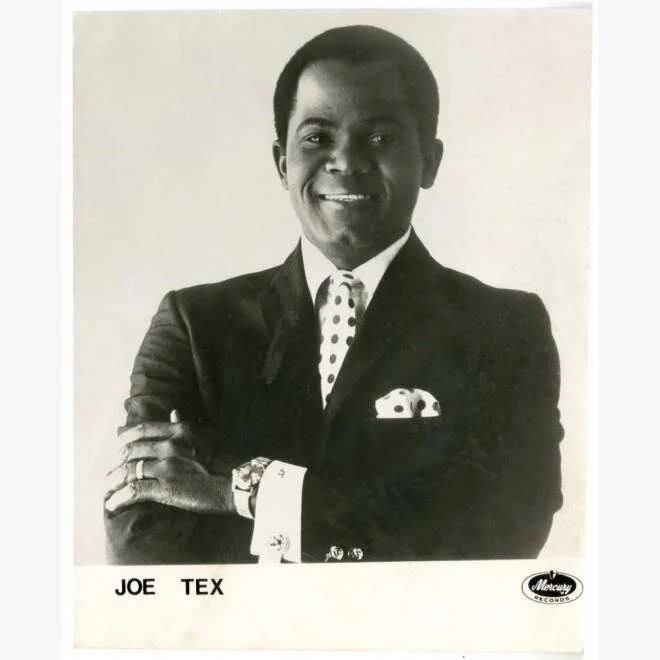Bass drum figures are seriously important, especially what I call the “push beat”, a 16th note bass drum note leading into the next downbeat. This can create the whole feel of the track.
Any double BD notes are also very, very popular. For example, two BD notes on the “ands” and “a’s”, the “e’s” and “ands”, and a BD note on a quarter note followed by another BD on the “e”.
1 - Song Examples
Here are some song examples with some more serious bass drum work.
a) “Papa Was Too,” Joe Tex, Clyde Williams, drums.
This song has “push beats” all over the place. A great example to practice with and also a challenging form.
Quiz 1
What’s the form “Papa Was Too”?
After the 7 bar intro:
- 5,10,9,12,5,4 ride out
- 5,9,4,5,11,5,4 ride out
- 5,5,5,11,5,4 ride out
Answer B: 5,9,4,5,11,5,4 ride out
Drummer and bandleader, of the Joe Tex Band, Clyde Williams, with saxophonist Rashad Oshama
b) “Funky Stuff,” Kool & the Gang, Funky George Brown, drums
Listen for the double BD notes on “3” and the “e of 3” and “4” and the “e of 4” in the first bar of this two-bar phrase.
Kool & the Gang. Drummer George Brown is in the upper right corner.
“Funky Stuff” drum beat:
c) “Dry Spell,” The Meters, Joseph “Zigaboo” Modeliste, drums.
Some nice 16th note BD work.
The Meters. Drummer Joseph “Zigaboo” Modeliste is holding out his hand.
d) “Work To Do,” Average White Band, Robbie McIntosh, drums.
A little more work to do here. Push beat plus several 16th doubles as well as syncopated BD on “e’s” and “a’s”.
The Average White Band. Drummer Robbie McIntosh is in the lower right.
e) “Hottentot,” John Scofield, Billy Martin, drums, from the A Go Go album.
Double 16th note BDs on “1” and the “e of 1”, and the “and” and “a” of 2”. The whole rhythmic groove is based around this figure. Notice how Billy Martin improvises around this basic figure.
Billy Martin
f) “Fire,” The Ohio Players, James “Diamond” Williams, drums
Classic 16th BD double on “and” and “a” of “2” and followed by unusual BD quarters and 8ths .
“Fire” drum beat:
The Ohio Players. Drummer James “Diamond” Williams is on the far left.
g) “If I Ever Loose This Heaven,” Average White Band, Steve Ferrone, drums.
BD 16th doubles on “1” and the “a of 1.” I find this is one of the hardest doubles to execute, but it sounds great. Listen for the different HH pattern in the bridge.
The Average White Band. Drummer Steve Ferrone is in the back row, right.
h) “Mr. Big Stuff,” Jean Knight, James Stroud, drums.
Push beat plus syncopated BD on a classic track.
James Stroud
i) “Yes We Can Can,” The Pointer Sisters, Gaylord Birch, drums.
If you can play along to this one smoothly you’ve got the real makings of a “good foot.” It’s just fast enough to be a real challenge. And this is where we start to understand what the concept of endurance is all about. It’s one thing to play a few bars but for a whole tune??? Different story.
2 - Push Beat Exercise
“The Payback,” James Brown, John “Jab’o” Starks, drums
Here’s the original track. The drums are laying heavy on the push beat so that’s why I use this track for practice.
“The Payback” slowed down.
Here’s a slowed down version of The Payback to practice to. Make sure you put the right amount of space between the notes. Don’t put the pick up BD note too close to the next quarter note. Give each of the notes their full value.
3 – Bass Drum Exercises
Here’s the real work for this lesson. Let’s go back to Funk Drumming, Jim Payne, p. 39-41 and increase the tempo a little. I know we never like to go back but this is serious!
We’ll up the tempo to Quarter note = 87 bpm.
Same routine:
Work on each line until it’s solid and smooth.
Play each line 4X’s and go down the pages.
If your foot just isn’t cutting it, STOP and SLOW DOWN THE TEMPO! Slow, consistent practice will eventually build speed. If you’re practicing too fast you’re wasting your time and you’ll get no results.
4 - Video Groove Examples
Watch and play along to the videos 3.02-3.09 in Advanced Funk Drumming, p.13 & 14. Check the transcriptions as well.
Workbook
Use this beat and play to Groove 5 Fast, Groove Essentials 1.0
NOTE: There are a lot of bass drum notes in this beat (maybe too many!). Feel free to leave some out, but make it consistent. Once you settle on a beat, repeat it.
Note: there should be an accent on beat 4 on the SD in the 2nd bar.
IMPORTANT: Play this chart in half-time. In other words, play one back beat per measure. Instead of counting 1,&,2,&,3,&,4,&; count 1e&a, etc (same pulse, same # of syllables). A two-bar bass solo will only take up one bar in the 16th note count. When it says Play 8, you'll be playing 4.
Another way to approach this counting is listen to the count-off clicks on the track and count 1,2,3,4 along with them. Play your backbeats on 3. Then when it says play 8 you’ll also be counting 8 bars.
Video of me playing to Groove 5 fast:



















